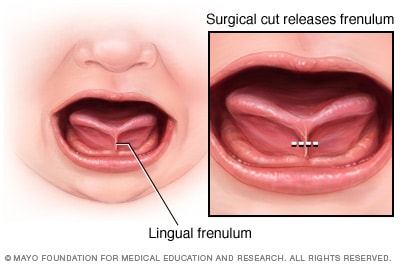Diagnosis
Tongue-tie is typically diagnosed during a physical exam. For infants, the doctor might use a screening tool to score various aspects of the tongue's appearance and ability to move.
Treatment
Treatment for tongue-tie is controversial. Some doctors and lactation consultants recommend correcting it right away — even before a newborn is discharged from the hospital. Others prefer to take a wait-and-see approach.
The lingual frenulum may loosen over time, resolving tongue-tie. In other cases, tongue-tie persists without causing problems. In some cases, consultation with a lactation consultant can assist with breast-feeding, and speech therapy with a speech-language pathologist may help improve speech sounds.
Surgical treatment of tongue-tie may be needed for infants, children or adults if tongue-tie causes problems. Surgical procedures include a frenotomy or frenuloplasty.
Frenotomy
Tongue-tie

Tongue-tie
Tongue-tie (ankyloglossia) is a condition in which an unusually short, thick or tight band of tissue (lingual frenulum) tethers the bottom of the tongue's tip to the floor of the mouth. If necessary, tongue-tie can be treated with a surgical cut to release the frenulum (frenotomy). If additional repair is needed or the lingual frenulum is too thick for a frenotomy, a more extensive procedure known as a frenuloplasty might be an option.
A simple surgical procedure called a frenotomy can be done with or without anesthesia in the hospital nursery or doctor's office.
The doctor examines the lingual frenulum and then uses sterile scissors to snip the frenulum free. The procedure is quick and discomfort is minimal since there are few nerve endings or blood vessels in the lingual frenulum.
If any bleeding occurs, it's likely to be only a drop or two of blood. After the procedure, a baby can breast-feed immediately.
Complications of a frenotomy are rare — but could include bleeding or infection, or damage to the tongue or salivary glands. It's also possible to have scarring or for the frenulum to reattach to the base of the tongue.
Frenuloplasty
A more extensive procedure known as a frenuloplasty might be recommended if additional repair is needed or the lingual frenulum is too thick for a frenotomy.
A frenuloplasty is done under general anesthesia with surgical tools. After the frenulum is released, the wound is usually closed with sutures that absorb on their own as the tongue heals.
Possible complications of a frenuloplasty are similar to a frenotomy and are rare — bleeding or infection, or damage to the tongue or salivary glands. Scarring is possible due to the more extensive nature of the procedure, as are reactions to anesthesia.
After a frenuloplasty, tongue exercises might be recommended to enhance tongue movement and reduce the potential for scarring.
Preparing for your appointment
Here's some information to help you get ready for your appointment and know what to expect from your doctor.
What you can do
Prepare a list of questions ahead of time, such as:
- How severe is the tongue-tie?
- Is treatment needed?
- What are the treatment options?
- Should I consider surgical correction?
- What's involved in surgical correction? What are the risks?
- Is anesthesia necessary?
- Will surgical correction improve my child's ability to get more milk during breast-feeding?
- Can the procedure be done in the office or hospital nursery?
- Do I need to consult an ear, nose and throat doctor or other specialist?
What to expect from your doctor
The doctor is likely to ask you a number of questions. For example:
- If your infant has tongue-tie, are you having trouble breast-feeding him or her?
- If your older child has tongue-tie, is he or she having trouble making certain sounds or taking care of his or her teeth?
- Is a gap developing between your child's two bottom front teeth?
- If you have tongue-tie, are you concerned about activities you're not able to do because of limited tongue movement?
Preparing and anticipating questions will help you make the most of your time with the doctor.